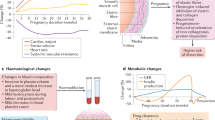Abstract
Hypertension arising during pregnancy remains one of the two most frequently-cited causes of maternal death in the UK. In some cases, pregnancy is unmasking underlying hypertension, which manifests itself in later life. Pregnant women who develop de novo proteinuric hypertension (pre-eclampsia, PE) can share many risk factors with patients with the metabolic syndrome, such as obesity, dyslipidaemia and insulin resistance. However, more than half the women who develop PE remain normotensive thereafter. There is a genetic component(s) to the disease, but it is most improbable that there is a ‘PE gene’. Rather, there are factors such as genetically-determined thrombophilias which are predisposers but not prerequisites. Impaired placentation is a feature, with inadequate invasion of the spiral arteries by syncytiotrophoblast and poor remodelling. However, similiar features are found in association with non-hypertensive fetal growth restriction. Prospective studies have suggested a hyperdynamic circulation in early pregnancy, with cardiac output only falling in established disease. Baroreflex sensitivity is decreased in normal pregnancy, and still further decreased in established PE. Activation of endothelial cell function antedates the clinical diagnosis, and has features in common with atherosclerosis. Dyslipidaemia is common in PE and, viaoxidation of susceptible lipids, may contribute to endothelial activation. Oxidative ‘stress’ is increased in PE, perhaps through a variant of the hypoxia-reperfusion phenomenon in the developing intervillous spaces. Such early changes might then lead to the clinically-evident syndrome in susceptible women. PE is a protean, multi- system, multifactorial disease, the causes of which are only slightly less enigmatic than a decade ago.
This is a preview of subscription content, access via your institution
Access options
Subscribe to this journal
Receive 12 digital issues and online access to articles
$119.00 per year
only $9.92 per issue
Buy this article
- Purchase on Springer Link
- Instant access to full article PDF
Prices may be subject to local taxes which are calculated during checkout
Similar content being viewed by others
Author information
Authors and Affiliations
Rights and permissions
About this article
Cite this article
Broughton Pipkin, F., Roberts, J. Hypertension in pregnancy. J Hum Hypertens 14, 705–724 (2000). https://doi.org/10.1038/sj.jhh.1001018
Received:
Accepted:
Published:
Issue Date:
DOI: https://doi.org/10.1038/sj.jhh.1001018
Keywords
This article is cited by
-
Cardioautonomic control in pregnant individuals with advanced maternal age
Clinical Autonomic Research (2023)
-
Hypoxia-inducible miR-210 contributes to preeclampsia via targeting thrombospondin type I domain containing 7A
Scientific Reports (2016)
-
Sleepiness and sleep-disordered breathing during pregnancy
Sleep and Breathing (2016)
-
Risk of pregnancy-related hypertension within five years of exposure to bacteria-contaminated drinking water
Kidney International (2009)
-
The combination of ApoCIII, hepatic lipase and hormono sensitive lipase gene polymorphisms suggests an association with susceptibility to gestational hypertension
Journal of Human Genetics (2007)



